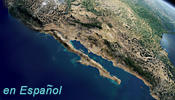![[Ocean Oasis Conservation]](images/bnr-conservation.gif)

![[Ocean Oasis Conservation]](images/bnr-conservation.gif) |  |
![[A History of Conservation Efforts in the Gulf of California]](images/history.gif)
|
||
|
|
Lindsay, Lindbergh, Krutch, Bechtel and the flying-boat expedition
In 1973, George Lindsay—one of Baja California's most eminent botanists—visited the islands of the Sea of Cortés together with Charles Lindbergh, Joseph Wood Krutch, and Kenneth Bechtel. Lindbergh, one of the most celebrated popular heroes of the 20th Century, had become by that time a committed conservationist, interested in the preservation of whales and in the conservation of nature at large. Joseph Wood Krutch, a naturalist, had written The Forgotten Peninsula, one of the first natural history descriptions of Baja California. George Lindsay had helped to organize a series of scientific explorations into the Sea of Cortés and the Peninsula of Baja California, first from the San Diego Natural History Museum, and later from the California Academy of Sciences (Banks 1962a and b, Lindsay 1962, 1964, 1966, 1970, and Wiggins 1962). Kenneth Bechtel, a philanthropist from San Francisco, had given financial support to the Audubon Society in the 1950s-60s to study the seabird rookery at Isla Rasa, which had been decreed a protected area by the Mexican government in 1962. Bechtel was interested in showing the Sea of Cortés to people, who after seeing its astounding natural beauty, might help to protect it. For this purpose, he organized the trip and invited Lindbergh to visit the region. The group flew a chartered Catalina flying-boat that allowed them to get to small remote islands. They landed in the water, and then piloted up to the beach so they could have shade under the wing. They visited many of the islands, starting from Consag, north of Bahía de los Angeles, and ending in Espíritu Santo, east of the Bay of La Paz. It was a wonderful and memorable trip. Two or three months later, both Lindbergh and Lindsay traveled to Mexico City, to watch the Mexican premiere of a documentary film on the Sea of Cortés that Kenneth Bechtel had sponsored. Taking advantage of the opportunity, and also of his immense popularity, Charles Lindbergh asked to see the President of Mexico, Luis Echeverria. Unfortunately, the President was abroad, on a foreign tour to Asia. The President's Secretary met them, possibly expecting to hear some ideas from Lindbergh with respect to aviation in Mexico. Much to his amazement, he heard Lindbergh ranting passionately about Baja California, and especially about the islands of the Sea of Cortés. Later, Lindbergh called the American ambassador and asked him to organize a press conference for representatives from the Mexican media. Shortly after, the startled George Lindsay saw the editors of about five major Mexican newspapers come into their suite at the Hotel del Prado, in front of the alameda in downtown Mexico City. The media leaders were eager to meet Lindbergh, expecting an interview on aviation and perhaps on Lindbergh's heroic solo flight across the Atlantic. With astonishment, they heard him preach about the immense natural wealth and the beauty of the Sea of Cortés. A few months after that trip, in August 26, 1974, Charles Lindbergh died. He never saw the Gulf Islands under any type of legal protection. Four years after his surprising appearance in Mexico City, however, a decree was issued protecting all of the islands of the Gulf of California. George Lindsay firmly believes that Lindbergh's intervention helped to promote the necessary governmental awareness that resulted in this decree. (SDNHM 1996). He is probably right: The combined momentum of the individual efforts of devoted conservationists and scientists has brought the Islands of the Sea of Cortés under increasing levels of conservation. Many naturalists have devoted their best efforts to the protection of the Sea of Cortés.
Continue to |
|
Text adapted from the conservation chapter of the book Island Biogeography in the Sea of Cortés, a forthcoming volume edited by Ted Case, Martin Cody, and Exequiel Ezcurra. The chapter was authored by Luis Bourillon, Antonio Cantú, Exequiel Ezcurra, María Elena Martínez, and Alejandro Robles. |
Photograph of Isla Espíritu Santo by Bradford Hollingsworth
Conservation | Site Index | Ocean Oasis
San Diego Natural History Museum & PRONATURA
© 2000 CinemaCorp of the Californias